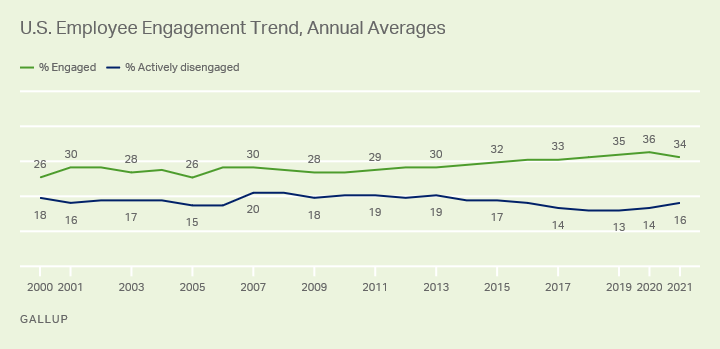Story Highlights
- Employee engagement had been steady at 36% during the first half of 2021
- Managers and healthcare workers had the steepest declines in engagement
- Boosting engagement requires a focus on the fundamentals
For the first year in more than a decade, the percentage of engaged workers in the U.S. declined in 2021. Just over one-third of employees (34%) were engaged, and 16% were actively disengaged in their work and workplace, based on a random sample of 57,022 full- and part-time employees throughout the year. This compares with 36% engaged and 14% actively disengaged in 2020, a year with unprecedented highs and lows.
Employee engagement in the U.S., even amid the pandemic-driven disruptions of 2020, continued to pace upward, reinforcing a decade-long steady improvement pattern that led to record highs.
In the first half of 2021, Gallup reported that 36% of workers were engaged, matching the 2020 composite result. But the second half of 2021 saw a drop, resulting in the annual figure of 34% engaged workers in 2021. This may not be surprising given the many challenges leadership faced in recent months, including record increases in employee quit rates, implementing vaccine mandates, and planning for various combinations of remote and on-site work while trying to match worker preferences with leadership expectations.
The ratio of engaged to actively disengaged workers in the U.S. is 2.1 to 1, down from 2.6 to 1 in 2020.
Gallup measures employee engagement by asking random samples of the working population about specific workplace elements that link to many organizational outcomes, including profitability, productivity, customer service, retention, safety and overall wellbeing.
These elements include clarity of expectations, opportunities for development and opinions counting at work. In short, engaged employees are involved in and enthusiastic about their work and workplace. Actively disengaged employees are disgruntled and disloyal because most of their workplace needs are unmet.

U.S. employee engagement trend from 2000 to 2021 showing that for the first year in more than a decade, the percentage of engaged workers in the U.S. declined in 2021 (to 34%).
Additional Findings and Implications
Organizations have lost sight of the basics. Among the engagement elements Gallup measures, the greatest declines were in clarity of expectations, having the right materials and equipment, and the opportunity for workers to do what they do best. These elements are foundational to employee engagement.
Managers and healthcare workers are less engaged. Employees who saw the most decline in engagement in 2021 included healthcare or social assistance workers (a 12-percentage-point decline) and managers (a seven-point decline). Specifically, healthcare workers saw the greatest declines in feeling that someone at work cares about them, someone encourages their development, they have an opportunity to do what they do best, they have clear expectations, they have the materials and equipment they need to do their job right, and their opinions count at work. Managers saw the steepest declines in feeling that they have clear expectations and someone who encourages their development.
Pandemic-driven economic, workplace, and mental and physical health challenges have hit healthcare workers and managers particularly hard. Gallup recently reported a significant increase in manager burnout in 2021.
Many organizations had more engaged employees in 2021. Not all organizations experienced declining engagement in 2021. Gallup's review of the hundreds of organizations in our database finds positive momentum in 2021, mostly from organizations that actively practice employee engagement fundamentals -- senior management involvement, communication, upskilling managers and accountability. These time-tested fundamentals consistently lead to improvements in engagement and performance, regardless of the surrounding disruptions.
What You Can Do
Focus on the basics. During significant turmoil, the basic elements of employee engagement become vulnerable, as was evident in 2021. Employees' confidence that they know what's expected of them, have the right materials and equipment, and have the opportunity to do what they do best declined the most. Getting these basic elements right increases resiliency.
Gallup found that during the first half of 2020, half of employees strongly agreed that they felt well prepared to do their job. This figure has since declined by seven percentage points. During a second year of fluid and unpredictable change, managers have continuously adjusted roles and resource needs. Many teams have new, or fewer, team members. Reestablishing role clarity has to be an ongoing ritual, leveraging each person's strengths in the process.
Provide clear and frequent communication from leadership. Managers are responsible for implementing leadership decisions while motivating their team to get work done.
And currently, concerns about employees' mental and physical health, compliance with vaccine mandates, ongoing changes to where people work, and increases in quit rates -- the "Great Resignation" -- are further complicating the manager's role. In early 2020, nearly half of employees (49%) strongly agreed that their supervisor keeps them informed about what is going on in the organization. This figure has since slipped to 36%.
Managers can only keep employees informed and engaged if organizational priorities are clear and well communicated as changes occur. Fuzzy or confusing messaging from the top only makes managers' lives more stressful.
Manage your managers. Manager engagement is on the decline, and burnout is on the rise. Clarity of expectations and opportunities to develop are specifically vulnerable. Like your employees, your front-line managers and supervisors need to feel that they are continually developing in their work and overall life. Managers and team leaders need to have coaching conversations with their manager, just as they are expected to do with their employees. It is almost impossible to engage your employees if managers themselves are burned out and not engaged.
As work and life are now more blended than ever, it is imperative that organizations address and manage not just employee engagement but also the five elements of wellbeing (career, social, financial, physical and community) -- uncovered by Gallup -- to reduce the odds of burnout, stress, worry, anxiety and depression.
Managers can only keep employees informed and engaged if organizational priorities are clear and well communicated as changes occur. Fuzzy or confusing messaging from the top only makes managers' lives more stressful.
Gallup has recently found that employees who were struggling or suffering in March were almost twice as likely than those who were thriving to change jobs later in the year. This was true for managers, too. Organizations can influence the overall lives of their managers with the right strengths-based coaching conversations about their work and wellbeing.
You can help make managers' jobs easier by upskilling them to have quality conversations -- at the right intervals -- with their employees that capitalize on their employees' strengths.
Organizations thrive when they create highly engaged employees.
- Learn more about employee engagement and how to improve it.
- See why the most successful organizations have effective engagement strategies.
- Discover the correlation between engagement and performance.





